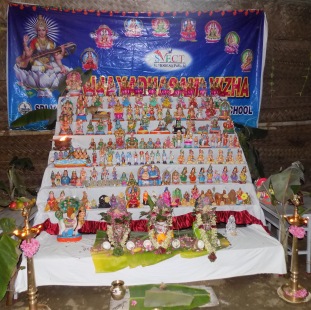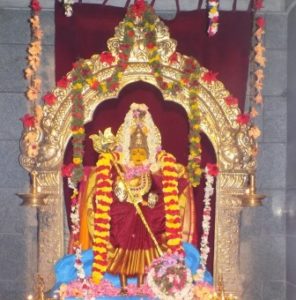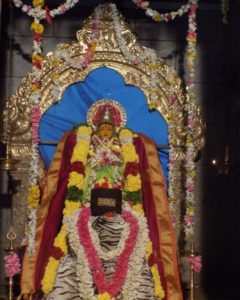NAVARATHIRI CELEBRATION -Navratri is one of the largest Hindu festivals celebrated every year. The festival of Navratri is marked by the celebrations of nine days. On each day one of the nine incarnations of the Goddedd Shakti is worshipped. The nine incarnations of the Goddess can be listed as follows; “Maa Shailputri”, “Maa Brahamcharini”, “Maa Chandraghanta”, “maa Kushmanda”, “Maa Skandamata”, “Maa Katyayani”, “Maa Kalratri”, “Maa Mahagauri” and “Maa Siddhidatri”. The festival of Navaratri owes its origin to a number of historic legends and stories. The festival is celebrated in various parts of the country along with different rituals but however the central idea remains the same. Apart from India the festival is celebrated with much pomp and rejoicings in different parts of the world .



NAVARATHIRI CELEBRATION
SUMMATIVE ASSESSMENT -I
Summative Assessment -I, 2017 for the classes L.K.G. to III will commence from 18.09.2017 and end by 23.09.2017.
TEACHERS’ DAY CELEBRATION
TEACHERS’ DAY CELEBRATION – Teachers’ Day is celebrated every year on 5th of September to honor and acknowledge the contribution made by countless numbers of teachers in helping and molding the careers of lakhs of students and in turn shaping the destiny.
The day was marked for the celebration as Teachers’ Day since 1962 in respect and deference of Dr. Sarvepalli Radhakrishnan who was born on 5th September, 1888. Dr. Sarvepalli Radhakrishnan was a great scholar, philosopher and teacher of modern India and was awarded the Bharat Ratna in 1954. He became the first Vice President of India (from 1952 to 1962) and the second President of India (from 1962 to 1967). It was his wish that instead of celebrating his birthday on 5th of September every year, it would be better to celebrate it as Teachers’ Day all over India.
JANMASHTAMI CELEBRATION
Janmashtami is one of the India’s most popular festival celebrated across the country with great zest and zeal, to commemorate the birth of Lord Krishna. Considered one of the most powerful human incarnations of Lord Vishnu, Krishna was born around 5,200 years ago in Mathura. The sole objective of Lord Krishna’s birth was to free the Earth from the evilness of demons. He played an important role in Mahabharata and propagated the theory of bhakti and good karma.
The festival of Janmashtami also referred to as Krishna Janmashtami, Saatam Aatham, Gokulashtami, Ashtami Rohini or Srikrishna Jayanti marks the birthday of Lord Krishna, one of the most powerful human incarnations of Lord Vishnu.
According to the Hindu calendar, this religious festival is observed on the eighth day after the full moon of Shravana. It is believed that Lord Krishna took birth at midnight on the ashtami or the 8th day of the Krishnapaksha in the Hindu month of Shravan (August-September).
On Janmashtami, a lot of devotees of Lord Krishna observe a fast for the whole day and night, worship him and listen to his tales, recite hymns from the Gita, sing devotional songs, and chant the mantras.
As per Hindu mythology, Lord Krishna was born inside Mathura jail on a dark, windy and rainy night. The doors of the jail opened on their own, and his father Vasudev, who was imprisoned by Krishna’s uncle (mama) Kansa, was released.
All over India, this festival is celebrated with great pomp and show. Krishna’s birthplace Mathura and Vrindavan observe this day with an unmatched zeal and grandeur. Raslilas or religious plays are performed to recreate incidents from the life of Krishna and to commemorate his love for Radha.
Our Vidhya Vishwalaya– Global School of Secondary education-CBSE a unit of SVECT schools celebrated the Gokulashtami with pooja and screened a movie on Little Krishna.
INDEPENDENCE DAY CELEBRATION
Independence Day in India – The Independence Day of India is celebrated on the 15th of August to commemorate the birth of a free and democratic nation. 15th August, 1947 is the historic day that marks India’s freedom from the stranglehold of the British Raj. On the eve of 15th August 1947, the Indian flag was unfurled proudly by Jawahar Lal Nehru, the first Prime Minister of India, at the Red Fort in Delhi. Jawaharlal Nehru’s landmark ‘tryst with destiny’ has gone down in the annals of Independent India as a proud moment for Indians. Thus India’s Independence Day is a deeply inspiring day and a day to revel in the freedom and glory regained by our freedom fighters
On the eve of India’s Independence Day, the President of India addresses the nation with a heartwarming speech which is telecast on television. On 15th August every year, the Prime Minister of India hoists the national flag at Red Fort in Delhi, followed by the official 21-gun salute and the Prime Minister’s Address. The national anthem is sung and makes every Indian’s heart fill with pride as the music drifts through this monumental structure, once regarded as a bastion of power.
Celebrations on Indian Independence Day
The Indian Independence Day is celebrated in all parts of the country with fervent zeal and patriotism. The day ritualistically starts with unfurling of the national flag, followed by a speech and participation in cultural activities in various schools and colleges, residential colonies and cultural institutions. Patriotic songs like “Vande Mataram” and “Jana Gana Mana” are sung and start off any musical concert or programme.
Vidhya Vishwalaya – Global School of Secondary education-CBSE a unit of SVECT schools celebrated the 71st Independence day’ with pomp and pleasure. The displays and a skit conducted by the students was applauded by the parents.
-
ADDRESS
Pilchinampalayam (Manalmedu)
Samathur post, Pollachi - 642 123. -
PHONE
-
EMAIL





